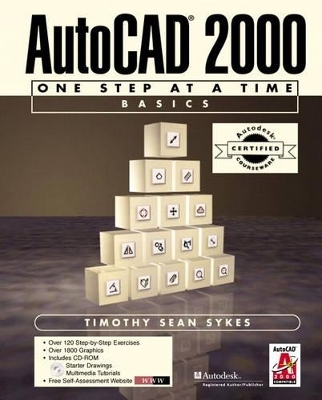
ACC Version-AutoCAD 2000
Peachpit Press Publications
978-0-13-089733-6 (ISBN)
- Titel ist leider vergriffen;
keine Neuauflage - Artikel merken
For courses in AutoCAD-Computer Aided Drawing.
A text designed for novice AutoCAD users that is ideal for either classroom use or independent study. Sykes uses a step-by-step approach and over 1800 graphics to make learning AutoCAD 2000 easy. This book takes a three pronged approach to teaching AutoCAD by integrating text, CD-ROM, and web-based support to create a complete learning system.
TIMOTHY SEAN SYKES has been an instructor at Houston Community College and North Harris College in Houston, TX for the past 5 years. Tim has a degree in secondary education from Lamar University. Prior to teaching, he spent 16 years as a designer in the Piping, Furniture, Structural, and Display fields. Tim has extensive writing experience; he has worked as a freelance writer, published two cookbooks, written a newsletter, published two field guides for edible wild plants, and has written assembly instructions for modular and furniture construction articles.
(NOTE: Each chapter concludes with Extra Steps, What Have We Learned?, Exercises, and Review Questions.)I. THE BASICS.
1. Setup.
The Groundwork: How AutoCAD Handles Scale, Units, and Paper Size. Let's Get Started: The Startup Dialog Box. Using the Setup Wizard. The User Interface. Saving and Leaving a Drawing Session. Opening an Existing Drawing. Partial Open and Partial Load. Creating Templates. Creating a New Drawing Using a Template. Changing the Setup or Starting a New Drawing from Scratch.
2. Drawing Basics: Lines and Coordinates.
Lines and Rectangles. Fixing the Uh-Ohs: Erase, Undo, and Redo. Multiple-Object Selection Made Easy. The Cartesian Coordinate System.
3. Putting It on Paper.
First Things First: Setting Up Your Printer (or Plotter). Plot Styles. Setting Up the Page to Be Plotted. Printing the Drawing.
4. Drawing Aids.
The Simple Stuff: Ortho, Grid, Tracking, and Snap. And Now the Easy Way: DSettings. Never Miss the Point with OSNAPS. Running OSNAPS. Point Filters and Object Snap Tracking. Isometric Drafting.
5. Display Controls and Basic Text.
Getting Closer: The Zoom Command. Why Find It Twice: The View Command. Simple Text. Editing Text—The DDEdit Command. Finding and Replacing Text. Adding Flavor to Text with Style.
6. Geometric Shapes (Other Than Lines and Rectangles).
Getting around to Circles. “Squished” Circles and Isometric Circles: The Ellipse Command. Arcs: The Hard Way! Drawing Multisided Figures: The Polygon Command. Putting It All Together.
II. BEYOND THE BASICS.
7. Adding Flavor to Your Drawing with Layers.
The Simple Command Approach. Color, Linetype, and So Much More: Layers. Swapping Setups: The AutoCAD Design Center. The Scenario. Uh-Ohs, Boo Boos, Ah $%&#$s: The Miracles of CHProp and the Object Property Manager. And Again, the Easy Way to Modify: Matchprop.
8. Editing Your Drawing: Modification Procedures.
The Change Group. The Location and Number Group. Moving and Copying Objects between Drawings.
9. More Complex Lines: Polylines (and Light Weight Polylines).
Using the Pline Command for Wide Lines and Multisegmented Lines. The Most Useful of the Most Overlooked: AutoCAD's Inquiry Commands. Editing Polylines: The Pedit Command.
10. More Editing Tools.
Location and Number. More Commands in the Change Group. Putting It All Together.
III. SOME MORE ADVANCED TECHNIQUES.
11. Some Useful Drawing Tricks.
Equal or Measured Distances: The Divide and Measure Commands. So Where's the Point? From Outlines to Solids: The Solid and Donut Commands. More Object Selection Methods. Object Selection Filters: Quick Select.
12. Guidelines and Splines.
Contour Lines with the Spline Command. Change Splines: The Splinedit Command. Guidelines.
13. Advanced Lines: Multilines.
Many at Once: AutoCAD's Multilines and the MLine Command. Options, Options, Options: The MLStyle Command. Editing Multilines: The MLEdit Command. The Project.
14. Advanced Text: MText .
AutoCAD's Word Processor: The Multiline Text Editor. “Okay I Typed It, but I Don't Know If It's Right!”: AutoCAD's Spell Command. Find and Replace.
15. Basic Dimensioning.
First, Some Terminology. Dimension Creation: Dimension Commands. And Now the Easy Way: Quick Dimensioning (QDIM). Dimension Editing: The Dimedit and DimTedit Commands. Isometric Dimensioning.
16. Customizing Dimensions.
Creating Dimension Style: The DDim Command. Try One. Simple Repairs.
17. Advanced Modification Techniques.
Object Selection Settings: “A Whole New Ball Game!”: Editing with Grips.
IV. RAZZLE DAZZLE.
18. Hatching and Section Lines.
The Hatch Command. Boundary Hatching. Editing Hatched Areas. More Section Help: The Sketch Command.
19. Many as One: Groups and Blocks.
Paper Dolls: The Group Command. Groups with Blocks: The Block Command.
20. Advanced Blocks.
Creating Attributes. Editing Attributes. The Coup de Grâce: Using Attribute Information in Bills of Materials or Database Programs.
21. Afterword: Getting an Edge.
Creating Your Own Hotkeys: The Acad.PGP File. The Z-Direction. Looking Ahead.
Appendix A: Drawing Scales.
Appendix B: Function Keys and Their Uses.
Appendix C: Answers to Review Questions.
Appendix D: MText Keystrokes.
Appendix E: Dimension Variables.
Index.
| Erscheint lt. Verlag | 5.1.2001 |
|---|---|
| Verlagsort | Berkeley |
| Sprache | englisch |
| Maße | 203 x 254 mm |
| Gewicht | 1542 g |
| Themenwelt | Informatik ► Weitere Themen ► CAD-Programme |
| ISBN-10 | 0-13-089733-7 / 0130897337 |
| ISBN-13 | 978-0-13-089733-6 / 9780130897336 |
| Zustand | Neuware |
| Haben Sie eine Frage zum Produkt? |
aus dem Bereich
